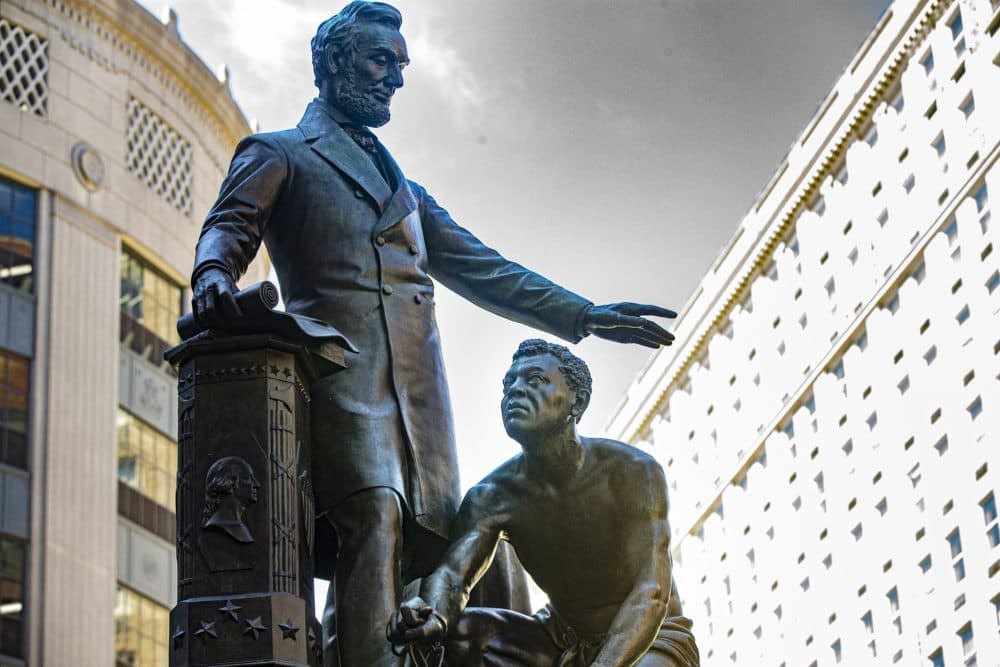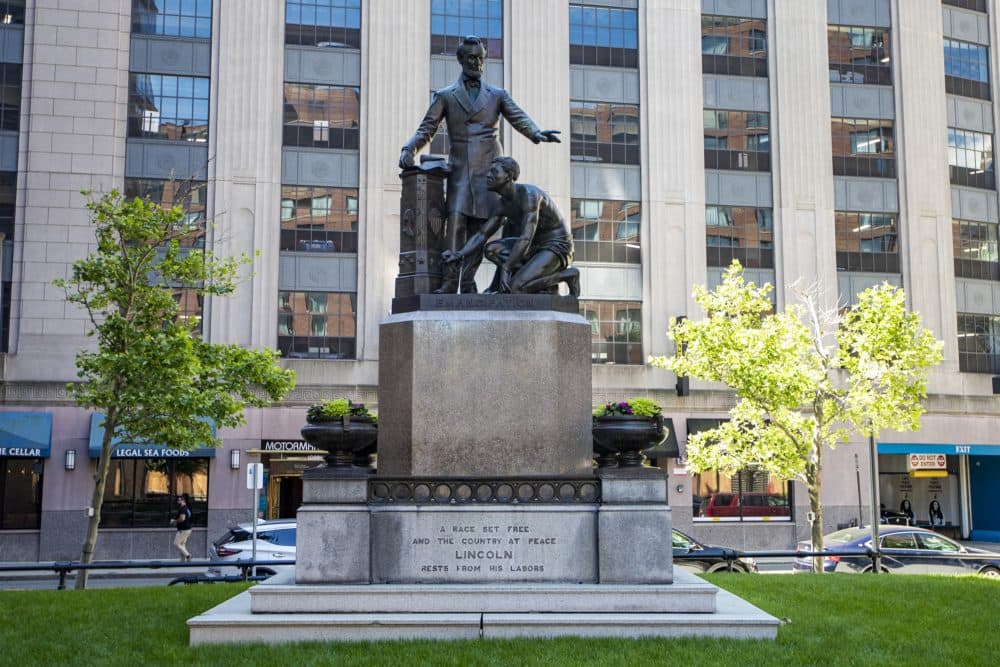Advertisement
Boston Art Commission Votes Unanimously To Remove Emancipation Memorial

Perhaps because it was a gift to the city from local politician Moses Kimball. Perhaps because the original copy of this statute in Washington, D.C., was fully funded by formerly enslaved people to honor their role in attaining freedom.
Maybe that's why it took so long to confront how uncomfortable Boston's replica of the "Emancipation Memorial" near the Park Plaza Hotel had been making people.
In a meeting on the evening of June 30, members of the Boston Art Commission voted unanimously to remove the copy of Thomas Ball's sculpture from Park Square. The work depicting a formerly enslaved man at the feet of Abraham Lincoln has stood there since 1879. Constructed shortly after Lincoln's assassination, the monument was dedicated just after the end of the Reconstruction era, a symbol that ultimately still depicted newly emancipated people as subservient to the white establishment and did nothing to acknowledge the contribution and role of black abolitionists.
The Boston Art Commission intends to have art conservators document the sculpture before recommending the best way to remove it and oversee the process. It will be placed into temporary storage. Documentation for the commission archives could include photography, drawings, a 3D scan, a history of the piece as well as the process the commission took to come to this decision. They're also planning to organize a public event that acknowledges the statue's history and informs the public.
Though the original sculpture was fully funded by formerly enslaved people, Ball designed without their input.
There is an inscription on the front of the piece that reads, "A race set free/ and the country at peace/ Lincoln/ Rests from his labors.”
Abraham Lincoln's right hand rests on the Emancipation Proclamation. His left is raised in a gesture of benediction above the crouched figure of Archer Alexander, a Black man who assisted the Union Army, escaped slavery and was recaptured under the Fugitive Slave Act, according to a release from the Boston Art Commission.
Alexander's pose was meant to be a man rising. But for artist and Dorchester resident Tory Bullock, Ball's work whitewashes history and denigrates an entire group of people. He started a petition to remove the statue, which garnered more than 12,000 signatures.
"This is a frozen picture. This man is kneeling, he will never stand up," Bullock said. "This image is problematic because it feeds into a narrative that Black people need to be led and freed. A narrative that seems very specific to us for some reason. Why is our trauma so glorified?"
Advertisement
At the commission's meeting, Howard University student and Haverhill resident Hannah Bessette called the statue “an affront to the movement happening around the country.”
“I am mortified at the vision of that statue. It is demeaning. It is degrading,” Bessette said. “Regardless of what the intentions were. It is important to note the intentions were white-based intentions, as it was a white-created statue.”

A handful of people who spoke at the meeting were in favor of keeping the sculpture where it is and adding context. But, commission member Robert Freeman said he had changed his mind after listening to two mothers in another recent virtual meeting who spoke of bringing their sons to see the sculpture. The boys immediately noticed the shirtless Black man with broken shackles on his wrists and ankles.
"And their son said, 'that statue looks like dad.' And the other said, 'it looks like me,'" Freeman said. "And then I realized that changing the inscription is not going to change the visual power of what art does. So I have changed my mind. I am now for the removal of the statue to a safe place."
Brandeis University emeritus professor Ibrahim Sundiata believes the sculpture belongs in a museum. He's a scholar who's written extensively on West African and African American history. He grew up in Washington, D.C., and says he used to walk past the statue nearly every day. As a kid, Sundiata said he thought it was creepy.
"I'm for preserving this statue, which troubled my 5-year-old mind, my 6-year-old mind, and is still in my memory at the same time," Sundiata said. "It needs to have people talk about where the pose came from, why the statue was paid for by freed men, and basically how that pose, those attitudes continue, how this sort of white paternalism informs us."
There will be temporary signage added to the site to interpret the statue before it's removed and permanent signage following the removal. The Boston Art Commission will continue this conversation at its July 14 virtual meeting.
At the end of the meeting, before giving a "joyful motion" to adjourn, commission vice-chair and artist Ekua Holmes reflected on what kind of imagery the newly emancipated people who funded this sculpture would have chosen, if they'd had the choice. Something more aspirational, more self-determining, she said.
Something timeless.
"Public art is storytelling at the street level. As such, the imagery should strike the heart and engage the mind," Holmes said. "...What I heard today is that it hurts to look at this piece, and in the Boston landscape we should not have works that bring shame to any groups of people, not only in Boston but across the entire United States."
